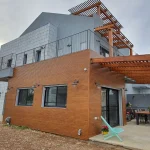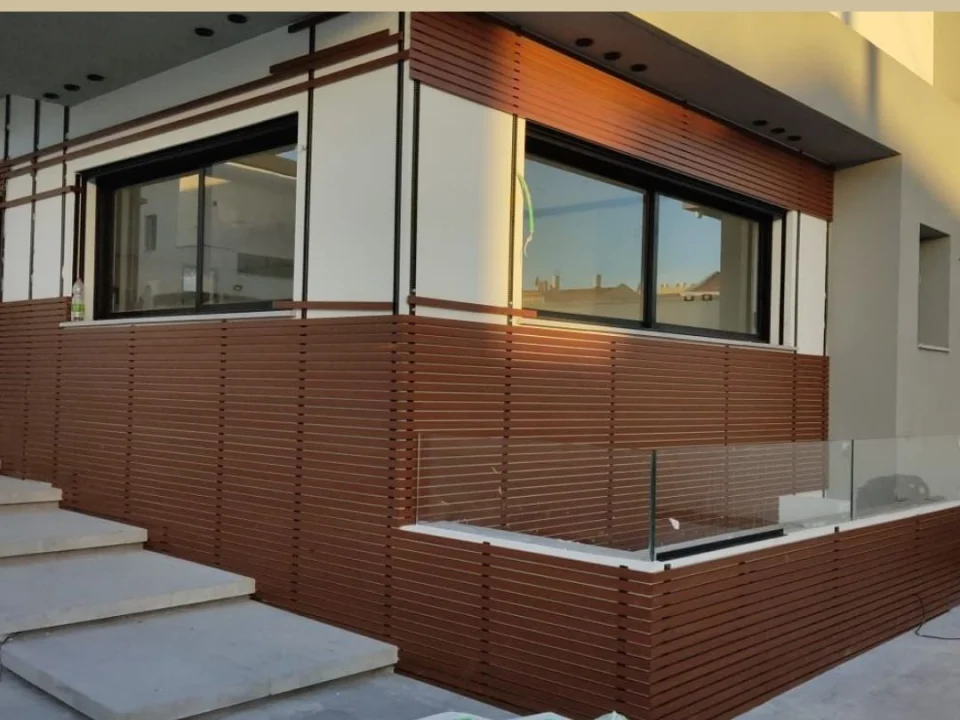
Aluminum Gate Designs with GTO Aluminum

Exterior Lightweight Cladding by GTO Aluminum
When you’re choosing cladding for a building, the options can feel overwhelming.
Do you pick an aluminum composite cladding (often called an ACM cladding system)? Or go for 100% aluminum panels, the pure metal route? Let’s break it down simply.
We’ll walk through what each option offers.
We’ll highlight problems with composite solutions.
We’ll show why our 100% aluminum panels stand apart.
And we’ll help designers, architects, and distributors understand what matters.
What is an ACM cladding system?
An ACM cladding system uses aluminum composite metal panels. You have two thin sheets of aluminum bonded to a core material. That core might be plastic (often polyethylene), mineral, or fire-retardant filler. That structure allows for light weight, flat finish, lots of colours and textures.
Architects like how commercial building cladding looks when they use these panels: clean lines, good flatness, design flexibility.
You’ll see metal panel sizes (widths, lengths) that fit big walls. Composite metal panel details often include how the core is made, how the skins of aluminum attach, how the panel is mounted.
And because of that, the commercial exterior wall panels made from ACM have been very popular for the last two decades.
What are 100% aluminum panels?
By contrast, 100% aluminum panels are just that: solid metal panels (or very nearly so) where the visible surface and the structural face are all aluminum alloy, not a sandwich with a plastic core. These can be thought of as aluminum wall panels rather than composite layers.
These panels eliminate the “mystery core” problem. You see metal, you know what you’re getting. They are durable, recyclable, lightweight (aluminum is lighter than steel), and simpler in construction.
If you’re a designer or distributor looking for the aluminum cladding manufacturer route, this approach gives clarity: no hidden plastic core, no future uncertainty.
Key comparisons: ACM cladding system vs 100% aluminum panels
Let’s look at the differences in plain terms.
Weight & handling
- ACM panels are light. The composite format makes them easier to move and install.
- 100% aluminum panels are also lightweight compared to many other materials (steel, heavy stone). They may weigh slightly more than the lightest composite in some cases, but the structural simplicity means easier fabrication and handling.
Design flexibility
- ACM offers great flatness and many finish options. For example you may see wood look aluminum panels (composite skins printed to mimic wood).
- 100% aluminum also offers textures and finishes – wood-look can be achieved in metal finishing, matte grey finishing etc. The difference is that you’re dealing with full metal, not hidden layers.
Durability & maintenance
- Composite panels: The sandwich structure can lead to future issues: delamination (the aluminum skin peeling off the core), warping under heat, hidden structural weaknesses.
- 100% aluminum: Because there’s no inner plastic core (in many designs), the risk of delamination is much lower. Maintenance is simpler: no hidden core to worry about.
Fire safety & hidden risks
- Here’s where ACM systems can be risky: If the core is combustible (such as polyethylene), the panel can behave very badly in a fire. Flames can spread rapidly through the cavity behind the cladding.
- With 100% aluminum panels, the risk of hidden combustible core is removed. Metal doesn’t burn in the way PE does. If you choose a true full aluminum product and ensure correct installation, you’re much safer.
Recyclability & sustainability
- Composite panels: because of the mixed materials (metal skins + polymer core), recycling is more complex.
- Pure aluminum panels: aluminum is highly recyclable, and many pieces of aluminum in use today are reused. That means better sustainability credentials.
Installation & cost factors
- ACM panels can be cost-effective initially, especially for large surface areas and when design demands are high.
- But installation complexities (ensuring fire breaks, proper mounting, dealing with core materials) can add hidden cost.
- 100% aluminum may cost a little more material-wise, but simpler structure, better durability, and fewer hidden risks often yield lower life-cycle cost.
Aesthetic outcomes
- Composite metal panels deliver crisp, modern aesthetics. They are great for façades that demand exacting flatness and colour variety.
- 100% aluminum panels give designers both modern looks and long-term confidence. If you are specifying industrial metal wall panels or finish panels for façades, knowing you aren’t compromising fire safety or hidden maintenance risk is a benefit.
Problems you face with composite solutions
Let’s be very clear. “Composite” doesn’t always mean “safe” or “future-proof”. Some key issues to watch:
If you use composite panels with a PE (polyethylene) core, you are exposing your façade to combustibility risk.
In a fire, the composite panel core may burn, delaminate or collapse, and the air gap behind the cladding can act like a chimney, letting flames shoot up the face of the building.
Many older ACM systems were installed before stricter fire regulations, meaning you might not even know the core material.
Even with fire-retardant cores (FR), composite panels are more complex to evaluate and install correctly.
In short: composite metal panel details matter a lot. The core, the installation method, the cavity behind matter. If the specification is poor, you could be building at risk.
Why our 100% aluminum panels stand out
Let me explain what our product line offers, and why it’s tailored for designers, architects, contractors and distributors who want clarity, performance and trust.
We manufacture 100% aluminum panels (rather than just aluminum skins over plastic cores). That means:
- No hidden combustible core. Real metal throughout.
- Lightweight, easy to handle. Cuts, clicks and fits without heavy welding or complex machinery.
- Designed with our installation systems (click-on or slide-in) to simplify job sites, reduce labour costs and speed up timeline.
- Multiple finishes: you want wood look aluminum panels? We’ve got it. You want grey matte modern finish? That too.
- High sustainability: aluminum is recyclable, robust long term, reduces maintenance.
- Fire-safe: Because metal is the material you see, you avoid the unknown in the wall system.
When we compare to the older ACM systems: you’re trading unknowns for certainty. You’re trading hidden risk for visible quality. And you’re choosing a system that contractors and distributors can trust and sell.
Installing made simple
Installation matters. In fact, a great product made complex to install becomes a headache. We solve that:
- Click System: Snap-on panels, rails pre-fixed, panels click in. Clean finish, minimal visible fixings. Great for projects where time is tight and detailing must be flawless.
- Universal Slide System: For applications where waterproofing and full enclosure matter, you slide panels in tongue-and-groove style. Zero visible seams, robust finish.
- Lightweight profiles, no heavy lifting. No welding required. Less manpower. Less time.
- For your distribution side: These systems sell well because they make contractors’ work easier. Clients get results faster. That means fewer delays, fewer surprises.
And for designers: you get a clean canvas. The metal finish, the textures, the colours are your creative play-field. Whether you go for wood tones or sleek metal greys, the look is modern and engineered.
Choosing the right panel size and system
Whether you are doing a commercial building cladding project or a smaller façade refresh, you need to think about metal panel sizes, how they mount, how they perform.
- For large surface areas, wider panels and longer lengths give fewer joints, cleaner finish.
- But you still need to think about expansion, substrate movement, fastening.
- Our 100% aluminum panels are designed for cut & fit. You can customize on-site. It gives flexibility for architects and installers.
- If you’re working with industrial metal wall panels or more rugged environments, full metal panels resist weather, corrosion and impact better than many composite systems.
Summary: The smart choice for façade projects
Here is how I’d summarise:
- If you go with a traditional aluminum composite cladding system, you may get great design flexibility and lower upfront cost. But you take on risk: core material unknowns, fire spread concerns, long-term durability questions.
- If you go with 100% aluminum panels, you get clarity: full metal, simpler structure, durable finish, easier installation, better sustainability and fewer hidden risks.
- For designers, architects and distributors who care about reputation, performance and future-proofing, the difference matters.
- In markets where building regulation and fire safety are tightening, specifying full metal panels gives you peace of mind.
- And for installation logistics, cut-and-fit, lightweight, faster job-site turnaround means cost savings.
Final word
When you compare “ACM cladding system vs 100% aluminum panels,” it’s not just a material choice. It’s a decision about performance, safety, reliability and aesthetics.
You want your building or your project to look great now, and still look great in ten, twenty, thirty years. You don’t want hidden problems or unpleasant surprises.
Choosing full aluminum panels means choosing simplicity, transparency and trust. If you’re a designer, specify with confidence. If you’re an architect, choose the material that matches your vision and your durability demands. If you’re a distributor or contractor, offer something your clients will thank you for years later.
FAQs
I’ve used ACM panels for years… but are these 100% aluminum panels really that different?
That’s a fair question, and honestly, it’s one many professionals ask. On paper, both may look similar: shiny metal sheets, clean lines, same modern finish. But once you touch and work with our panels, you feel the difference. No hidden plastic core. No fear of delamination or fire risk. No tricky installation that eats your time on site. Just pure aluminum, light, flexible, and solid all the way through.
If you’ve worked with ACM before, order our free sample box (with free shipping anywhere in the USA) and see the difference yourself. You’ll understand instantly why so many designers and distributors are switching to 100% aluminum.
I’m a designer. I care about looks, will full aluminum panels limit my creativity?
Absolutely not. We get it, you want your façade to stand out. You want warmth, depth, texture, and color. That’s why our panels come in wood-look aluminum panels, matte finishes, metallic tones, and custom shades. You can design freely, from rustic wood tones to sleek modern surfaces – all while staying within a material that’s strong, fire-safe, and sustainable.
Order your free sample box to feel the textures, see the finishes, and imagine your next project without limits. You’ll be surprised how much freedom full aluminum gives you.
I’m a distributor – what if my clients don’t believe aluminum is worth it?
That’s exactly why we offer sample boxes shipped free anywhere in the USA. Once your clients hold it, the argument ends. They’ll feel the strength, the lightness, and the quality in their hands. It’s not about selling another panel, it’s about offering something you can stand behind. Something safer, longer-lasting, and easier to install. Your reputation matters. When your clients trust your product, they trust you. Let us send you a free distributor sample kit, and together we’ll show your clients what premium truly feels like.





